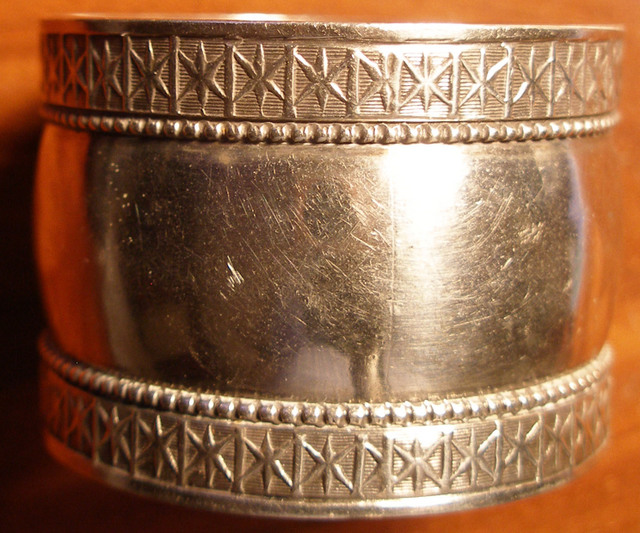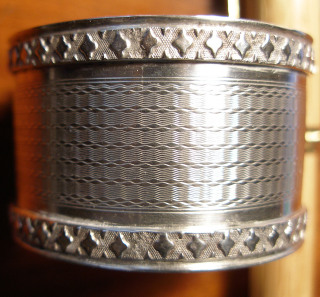|
A GLOSSARY of MILLED BANDS
|
|
| How to Post Photos |
REGISTER (click here)
|
|
A GLOSSARY of MILLED BANDS
|
|
| How to Post Photos |
REGISTER (click here)
|

|
 SMP Silver Salon Forums SMP Silver Salon Forums
  American Silver before sterling American Silver before sterling
  Another milled band Another milled band
|
| next newest topic | next oldest topic |
| Author | Topic: Another milled band |
|
ahwt Posts: 2334 |
  
  Above is an unmarked napkin ring with milled bands around both edges. While unmarked I believe it to be made of solid silver and constructed during the coin period. The construction technique is obvious from the visible solder line and the way the milled bands were cut to join together. It also has the slight flexibility that solid silver has compared to silver plated napkin rings. This is a variation of the stars pattern, but I did not see this exact one in the glossary. IP: Logged |
|
ahwt Posts: 2334 |
  
 Above and below are a couple of napkin rings that have milled banding. The top one shows the solder line in the main portion of the napkin ring and both show where the milled bands were cut to be joined together. Neither one is marked in any manner, but both have the flexibility of solid silver. I would guess they are American and date from the 1850s or 60s. The bottom one has an egg and dart look while the top one has a repeating diamond symbol. It is my experience that most unmarked napkin rings are still sold as silver plate. Also children always seem to enjoy napkin rings and our children would always seek out their favorite one to use. I think napkins rings were a Victorian era invention, but I really have not found much written about them. IP: Logged |
|
swarter Moderator Posts: 2920 |
  
When you examine the edges of these rings, or the inside below the edges, can you see a seam or gap which would indicate a solder joint between a band and the body? The reason I ask is that I notice that the ends of the bands where they butt against each other in the first and second of the three bands correspond exactly with the seams in the bodies. My questrion, which might be answerable by one of our silversmith members, is whether, if the bands were applied to flat sheet silver before forming into the ring, would the bands not separate or otherwise interfere with the forming of the ring? If they were added later, as was the practice with hollow ware, their ends would not be likely to correspond so well with the seams. So if in place before forming would they be separate bands at all? [This message has been edited by swarter (edited 11-05-2007).] IP: Logged |
|
ahwt Posts: 2334 |
  
There is a seam on the third one, but it is so faint that I could not photograph it. It is in the same location as the others – extending through the whole ring at the point where the bands are joined. I could not see this seam on the inside of the third ring, but the seams are faintly visible on the other two It is actually opposite of what one sees on beakers as there one can normally see the inside seam better than the outside one. I could not see any seams on the inside where the milled bands would have been joined to the center portion. The first ring has the bowed out middle section so there is a line on the inside. It appears to me that the engine turning on one of the rings was accomplished after the seam was soldered together as the lines of the turning obliterate most of the visible seam. IP: Logged |
|
FWG Posts: 845 |
  
Not having one at hand but based on memory of the ones I've handled over the years, I think that many of these rings were milled as one piece - edge bands and center section - and then cut, rolled, and soldered. And then sometimes further finished, like with engine-turning or engraving. But relatively few I can remember have had signs that the milled bands were separate pieces. IP: Logged |
|
ahwt Posts: 2334 |
  
Milling all at once would make sense. Then the worker would just cut off the length required and solder the ends together. Whatever could not be accomplished in the first step could be finished up after the ring was made. IP: Logged |
|
wev Moderator Posts: 4121 |
  
Eli Henry Eldridge was issued a patent in 1866 for a hand-cranked, bench top rolling press for embossing running bands and spot decorations on napkin rings. He is listed as a Britannia manufacturer in Taunton MA c 1850-1880, so I imagine the rings were blanks made up for silver-plating, but the machine may well have been used for working in silver, as well. IP: Logged |
|
swarter Moderator Posts: 2920 |
  
Very interesting thread. Since these are not separate milled bands and represent a different period in time beyond the "coin period" (well into the second half of the Century), we will not be including them in the Glossary, but they are nice to see, nonetheless. Thanks for posting them. IP: Logged |
|
Polly Posts: 1970 |
  
Here's another milled band--or maybe it's two milled bands? I'm not sure. I don't know if anyone will be interested, since it's from a sterling creamer made in the second half of the 19th century, but still. Here's the band (or two bands): And here's the creamer (marked W&H sterling--with the "&" a sideways 3--for Wood & Hughes). IP: Logged |
All times are ET | next newest topic | next oldest topic |
  |
|
Ultimate Bulletin Board 5.46a
|
1. Public Silver Forums (open Free membership) - anyone with a valid e-mail address may register. Once you have received your Silver Salon Forum password, and then if you abide by the Silver Salon Forum Guidelines, you may start a thread or post a reply in the New Members' Forum. New Members who show a continued willingness to participate, to completely read and abide by the Guidelines will be allowed to post to the Member Public Forums. 2. Private Silver Salon Forums (invitational or $ donation membership) - The Private Silver Salon Forums require registration and special authorization to view, search, start a thread or to post a reply. Special authorization can be obtained in one of several ways: by Invitation; Annual $ Donation; or via Special Limited Membership. For more details click here (under development). 3. Administrative/Special Private Forums (special membership required) - These forums are reserved for special subjects or administrative discussion. These forums are not open to the public and require special authorization to view or post. |
|
copyright © 1993 - 2022
SM Publications
All Rights Reserved. Legal & Privacy Notices |